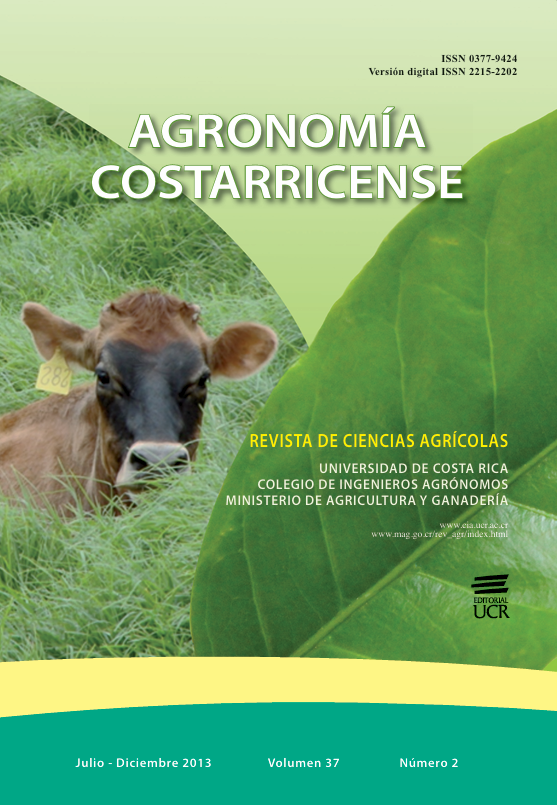Abstract
The aim of this study was to analyze the prevalence and grade of ketosis type I and II, and to examine risk factors related with this metabolic disease, in a 203 cows Jersey herd in Oreamuno, Cartago, Costa Rica (9° 55' North Latitude, 83° 51' West Longitude, 2350 m of altitude), to propose management and feeding practices that contribute to reduce de incidence of this metabolic imbalance. Prevalence of type II and type I ketosis was determined by measuring blood concentration of β-hydroxybutyric acid (βHBA) at 8±3 and 30±3 days in milk in 117 and in 114 animals, respectively. No clinical type II ketosis was detected, and 4.27% of the cows had subclinical (1.4 to 2.9 mmol.l-1) ketosis of this type. Percentages of cows with clinical (>2.9 mmol.l-1) and subclinical type I ketosis were 3.51 and 9.65, respectively. During the last week of gestation, body condition loss differed (p<0.05) for healthy and type I ketotic cows and was 0.09 and 0.31 points, respectively. Cows with type I ketosis were of greater (p<0.01) parity, longer (p<0.05) dry period length and greater (p<0.01)peak milk yield, than healthy cows. Results suggest that scoring body condition during the last week of gestation could be useful to predict the risk of the animals developing type I ketosis. Based on these results, management to avoid dry periods in excess of 60 days would help to reduce the incidence of ketosis. Furthermore, feeding and management practices of older and higher producing cows, to reduce the loss of body condition post calving, could also reduce the incidence of ketosis.References
ANDERSSON L. 1988. Subclinical ketosis in dairy cows. Metabolic diseases of ruminant livestock. Vet. Clin. North Am. Food Anim. Pract. 4:233-251.
AOAC. Association of Official Agricultural Chemists. 2000. Official methods of analysis. 16th ed. Washington, D. C.
BAIRT D.G. 1982. Primary ketosis in the high producing dairy cow: clinical and subclinical disorders, treatment, prevention and outlook. J. Dairy Sci. 65:1-10.
BOBE G., YOUNG J.W., BELTZ D.C. 2004. Invited review: pathology, etiology, prevention, and treatment of fatty liver in dairy cows. J. Dairy Sci. 87:3105-3124.
BUCKLEY F., DILLON P., CROSSE S., FLYNN F., RATH M. 2000. The performance of Holstein Friesian dairy cows of high and medium genetic merit of milk production on grass-based feeding systems. Livestock Production Science. 64:107-119.
COPPOCK C.E., EVERETT R.W., NATZKE R.P., AINSLIE H.R. 1974. Effect of dry period length on Holstein milk production and selected disorders at parturition. J. Dairy Sci. 57:712-718.
DRACKLEY J.K. 1997. Minimizing ketosis in high producing dairy cows, pp. 63-82. In: Tri-State Dairy Nutrition Conference. Fort Wayne, Indiana.
DUFFIELD T.F. 2000. Subclinical ketosis in lactating dairy cattle: Metabolic disorders of ruminants. Vet. Clin. North Am. Food Anim. Pract. 16:231-253.
EPPERSON W.B. 2005. Risk factors for metabolic disease, pp. 31-43. In: Tri-State Dairy Nutrition Conference. Fort Wayne.
FERGUSON J.D., GALLIGAN D.T., THOMSEN N. 1994. Principal descriptors of body condition score in Holstein cows. J. Dairy Sci. 77:2695-2703.
FRENCH P.D. 2006. Dry matter intake and blood parameters of non lactating Holstein and Jersey cows in late gestation. J. Dairy Sci. 89:1057-1061.
GEARHART M.A., CURTIS C.R., ERB H.N., SMITH R.D., SNIFFEN C.J., CHASE L.E., COOPER M.D. 1990. Relationship of changes in condition score to cow health in Holsteins. J. Dairy Sci. 73:3132-3140.
GILLUND P., REKSEN O., GROHN Y.T. KARLBERG K. 2001. Body condition related to ketosis and reproductive performance in Norwegian dairy cows. J. Dairy Sci. 84:1390-1396.
GRUMMER R.R. 1993. Etiology of lipid-related metabolic disorders in periparturient dairy cows. J. Dairy Sci. 76:3882-3896.
HAYIRLI A., GRUMMER R.R., NORDHEIM E.V., CRUMP P.M. 2002. Animal and dietary factors affecting feed intake during the prefresh transition period in Holstein. J. Dairy Sci. 85:3430-3443.
INSTITUTO METEOROLÓGICO NACIONAL (IMN). 2012. Información meteorológica de la provincia de Cartago. San José, Costa Rica.
IWERSEN M., FALKENBERG U., VOIGTSBERGER R., FORDERUNG D., HEUWIESER W. 2009. Evaluation of an electronic cowside test to detect subclinical ketosis in dairy cows. J. Dairy Sci. 92:2618-2624.
JOHNSON D.G., OTTERBY D.E. 1981. Influence of dry period diet on early postpartum health, feed intake, milk production, and reproductive efficiency of Holstein cows. J. Dairy Sci. 64:290-295.
JUCHEM S.O., sANTOS F.A.P., IMAIZUMI H., PIRES A.V., BERNABÉ E.C. 2004. Production and blood parameters of Holstein cows treated prepartum with sodium monensin or propylene glycol. J. Dairy Sci. 87:680-689.
MACKLE T.R., PARR C.R., STAKELUM G.K., BRYANT A.M., MACMILLAN K.L. 1996. Feed conversion efficiency, daily pasture intake, and milk production of primiparous Fresian and Jersey cows calved at two different live weights. N.Z.J. Agric. Res. 39:357-370.
NATIONAL RESEARCH COUNCIL. 2001. Nutrient Requirements of Dairy Cattle. 7th rev. ed. National Academy Press. Washington, D.C. 381 p.
NIELSEN N.I., FRIGGENS N.C., CHAGUNDA G.G., INGVARTSEN K.L. 2005. Predicting risk of ketosis in dairy cows using in-line measurements of β-hidroxibutyrate: a biological model. J. Dairy Sci. 88:2441-2453.
OETZEL G. 2007. Herd-Level Ketosis-Diagnosis and Risk Factors. American Association of Bovine Practitioners 40th Annual Conference, September 19, 2007–Vancouver, BC, Canada pp. 67-91.
OETZEL G., McGUIRK S. 2010. Fact Sheet-Cowside Blood BHBA Testing with a Hand-Held “Ketometer”. University of Wisconsin-Madison, School of Veterinary Medicine. Madison, Wisconsin, U.S.A. Consultado 30-8-2010, disponible en http://www.vetmed.wisc.edu/dms/fapm/fapmtools/tci/BHBATesting-Update-090305.pdf
PEDRON O., CHELI F., SENATORE E., BAROLI D., RIZZI R. 1993. Effect of body condition score at calving on performance, some blood parameters, and milk fat acid composition in dairy cows. J. Dairy Sci. 76:2528-2535.
PRENDIVILLE R., PIERCE K.M., BUCKLEY F. 2009. An evaluation of production efficiencies among lactating Holstein-Friesian, Jersey, and Jersey x Holstein Friesian cows at pasture. J. Dairy Sci. 92:6176-6185.
TREACHER R.J., REID I.M., ROBERTS C.J. 1986. Effect of body condition at calving on the health and performance of dairy cows. Anim. Prod. 43:1-6.
VAN SOEST P., ROBERTSON J., LEWIS B. 1991. Methods for dietary fiber, neutral detergent fiber and nonstarch polysaccharides in relation to animal nutrition. J. Dairy Sci. 74:3586-3597.
WATTERS R.D., GUENTHER J.N., BRICKNER A.E., RASTANI R.R., CRUMP P.M., CLARK P.W., GRUMMER R.R. 2008. Effects of dry period length on milk production and health on dairy cattle. J. Dairy Sci. 91:2595-2603.


